
We are celebrating 15 years — and counting — of stories that are deeply researched and deeply felt, that build a historical record of what the city has been.
We are celebrating 15 years — and counting — of stories that are deeply researched and deeply felt, that build a historical record of what the city has been.
While independent communications infrastructure, renewable energy, and resilient heating and power systems may all be major priorities in contemporary urban development, the three aren’t typically incorporated into the same project. Beyond The Grid — an ambitious plan underway in the Two Bridges neighborhood of Lower Manhattan — does just that. And the fact that the proposal has been created in this neighborhood is no accident.
With a high concentration of lower income residents, a geographic vulnerability to extreme weather, and a strong tradition of local activism, Two Bridges is the kind of place where ambition rises to address hidden challenges wrought by poverty, among them the inability to pay for food with EBT when the power is out or to acquire emergency information without Internet access. Two years ago, a few months shy of Sandy, Kerri Culhane brought Omnibus readers the story of a plan to make open spaces in the neighborhood both more inviting and environmentally productive. The reality of the devastation following the storm demanded an even more multifaceted approach to preparing and strengthening Two Bridges for the future. Culhane is now part of the Beyond the Grid team, a diverse and fascinating coalition of advocates, technologists, planners, and engineers. As Aaron Reiss explores in the article below, their plan has the potential to create a more resilient, connected, and sustainable Lower East Side if they can move past the regulatory, funding, and organizing hurdles that often obstruct visionary projects of this scale. –C.S.
A Man Outside the Box
When Paul Garrin first approached Two Bridges Neighborhood Council about installing a WiFi tower on their building in the Lower East Side, it was two years before Hurricane Sandy devastated communications infrastructure in the neighborhood. Long before the threat was on most people’s radar, Garrin had dreams of bringing community-based wireless internet service, powered by resilient, off-grid energy sources, to the residents of Lower Manhattan.
Two Bridges Neighborhood Council is a non-profit that develops affordable housing and advocates for quality of life improvements for the diverse residents of the Lower East Side. When asked why the organization was ready to work with Paul on something as untraditional as grassroots wireless internet, Kerri Culhane, the organization’s associate director, explained that Two Bridges’ leadership was “intrigued by Garrin’s commitment to operate outside the corporate system.” With a background that fuses architectural history with ecological planning and design, Culhane herself is often on the lookout for interdisciplinary projects and partners willing to take an inventive and empathetic approach to community-based advocacy.
“Paul is something,” Culhane told me, smiling over her cup of coffee at a small cafe on Essex Street, not far from Two Bridges’ tower at 82 Rutgers Slip. Having been an activist in the Lower East Side for over 20 years, Garrin has earned a reputation. “Everybody knew Paul in this neighborhood,” she said, recounting his role in local political demonstrations and his early partnership with avant-garde video artist Nam June Paik. He’s the type of Lower East Side denizen who’s steeped in a tradition of political activism in which the young, radical demonstrators of the 1970s and ’80s have aged to become well-established community advocates today.
When I first met Garrin across from Tompkins Square Park (where he shot footage of a 1988 riot that fueled a city investigation into police brutality), his long, silver pony-tail was pulled back above a high forehead. I was here to see Village East Towers, where Garrin had recently finished installing his newest WiFi tower, and the site where Garrin, Culhane, and a few other community advocates were building the early phases of a comprehensive neighborhood resiliency model dubbed “Beyond The Grid.”
As we walked, Garrin recounted his involvement in various projects over the years. He has the air of someone who enjoys taking on the infallible and the immovable in our society: governments, big developers, corporate oligarchies; he’s still battling the Internet Corporation for Assigned Names and Numbers (ICANN) in a ten-year lawsuit taking on the privatization of top-level internet domains (e.g., .nyc, .now, .art).
Talk of corporate cartels, government-backed monopolies, and conspiracy theories may raise eyebrows. But after getting past quick stereotypes, it becomes clear that Garrin picks battles where many of us would see a problem and simply shrug our shoulders. Garrin is not a shoulder-shrugger. So while his fights may seem radical at first blush, our conversation mostly revolved around small-scale, local, and very practical strategies for addressing important, large-scale societal ills. After speaking, I understood immediately why Two Bridges would want to work with him.
The WiFi-NY project, which Garrin founded in 2003, is a cooperative, community operated, locally implemented, grassroots WiFi service built to offer an affordable alternative to Comcast and Time Warners’ monopolies. Using towers that Garrin and his partner install and maintain themselves, WiFi-NY brings low-cost or free Internet service to people who would otherwise have a hard time affording access. The effort marries Garrin’s passion for the power of the Internet with his commitment to advocacy and contempt for the power concentrated in large corporations. In the aftermath of Hurricane Sandy, Garrin saw an opportunity to expand this functional, pragmatic solution to create a more comprehensive approach to disaster resilience.
A Loose Coalition
When Garrin initially approached Two Bridges about installing a tower on their 21-story mixed income building at 82 Rutgers Slip, the organization was excited about the potential that WiFi-NY could have for the community. Culhane believed it could serve as a mechanism for disseminating community news and a tool to connect their building’s six hundred plus residents to each other and to the wider community.
Another common concern in the community at that time was fair access to healthy food after the area’s major supermarket, Pathmark, was slated for demolition. Culhane reached out to James Johnson-Piett, CEO of Urbane Development, a consulting firm specializing in bringing equitable development to underserved communities, to discuss a system of locally connected information kiosks that could help direct neighbors to different sources of fresh food.
Together, this loose coalition — Paul Garrin, Kerri Culhane, and James Johnson-Piett — drew up plans for a network of community kiosks built on affordable wireless internet service that could help residents stay in touch, as well as find access to healthy and affordable food. They were well on their way in exploring the project’s feasibility when the events of October 2012 made those issues all the more urgent.
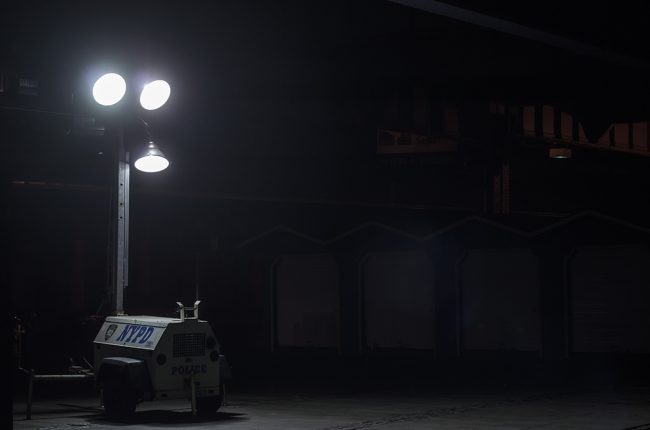
Flood lights in Lower Manhattan after Hurricane Sandy hit | Photo via DeShaun Craddock
The devastation wrought by Hurricane Sandy forced New York City to address its susceptibility to climate-related disasters. The infrastructure systems that power everyday life shut down in many affected areas: electricity, the natural gas supply, public transportation, mail delivery, and, crucially, the Electronic Benefits Transfer (EBT) system on which many New Yorkers rely to purchase food. In New York City alone, close to two million people lost power in blackouts ranging from a day to weeks in length — stranding residents on the upper floors of high rise buildings (elevators were out), preventing them from purchasing (EBT and credit card systems failed) and storing (no refrigeration without electricity) food, and preventing contact with the authorities and loved ones (internet went out, and cell phones died after a few days).
As residents of the Lower East Side, one of the areas hardest hit by the storm, Garrin and Culhane experienced the devastation firsthand. During Sandy, Kerri recalls, “people were calling [Two Bridges] asking, ‘Can you check on my mother? She’s on the 20th floor.’ So we were running up 20 flights of stairs to check on people, door by door.” Elderly residents of the Village East complex also suffered from a lack of elevators, water, and lights.
In this context, the team’s efforts to create a resilient, community-based communications and food access system took on more profound importance. “We saw firsthand the shortcomings of having no communications when trying to provide disaster relief within our own building, and to stage and distribute supplies community-wide,” says Culhane. So, as they began to reframe their project around disaster management and local resiliency, the team realized that the missing component of their plan was power. Without off-grid power, even locally based communication systems like WiFi-NY would last only as long as their batteries.
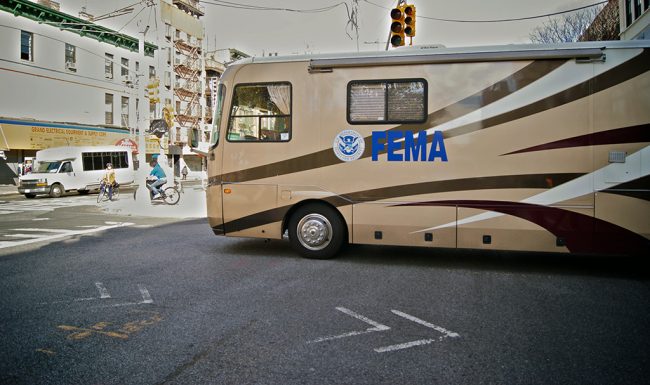
A FEMA truck on the Lower East Side post-Sandy | Photo via Saundi Wilson
Meanwhile, FEMA and other relief organizations were offering different solutions, based primarily on evacuation and emergency response. For Garrin, these suggestions were frustrating for their failure to take into account the realities of the neighborhood. Most residents of the Lower East Side, with its large population of immigrants and low- and middle-income residents, do not have second homes or family elsewhere to house them during an evacuation. Garrin didn’t shy away from expressing his dissent, telling FEMA representatives that their strategy “doesn’t really reflect the realities of this community because, indeed, people don’t want to evacuate. They want to shelter in place, they did shelter in place, … and they need to be safe to shelter in place.”
With that in mind, Garrin, Culhane, and Johnson-Piett began to dream up a plan that acknowledged the importance of marrying resilient communications infrastructure with off-grid power sourcing. They imagined whole neighborhoods linked together as small microgrids, powered by alternative energy sources — natural gas cogeneration (during Sandy, the natural gas grid proved significantly less vulnerable to disruption than the electrical grid), wind, and solar — and connected by community kiosks and a locally based WiFi service that could withstand another catastrophic electrical outrage.
Click here to launch a slideshow explaining each component of Beyond the Grid | Illustrations by Aaron Reiss
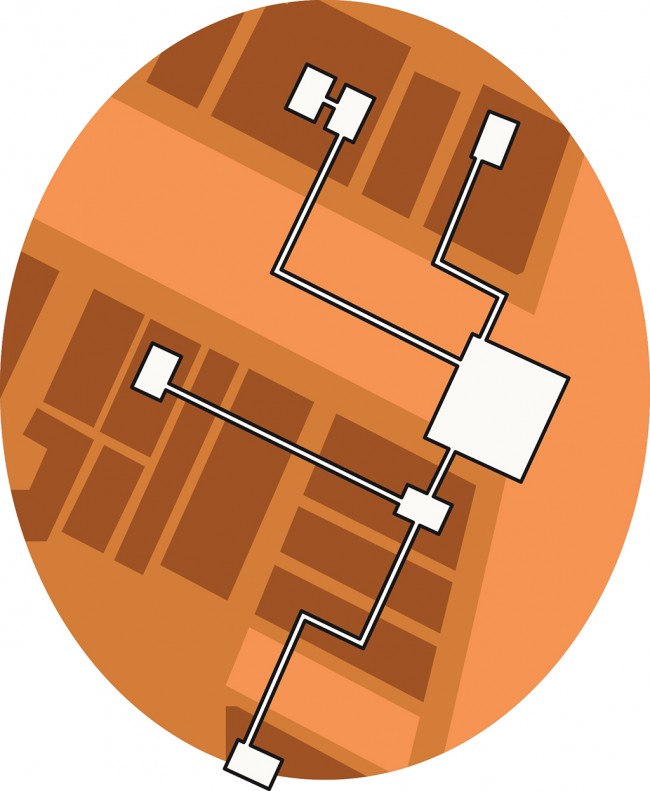
Microgrid: A collection of buildings outfitted with various methods for creating power locally (e.g., solar, wind, combined heating and power). Locally generated power is fed into local energy storage and management systems which, in theory, can run in tandem with the main grid (selling back extra energy) as well as run independently in the event of a disaster that puts the main grid out. | Illustration by Aaron Reiss
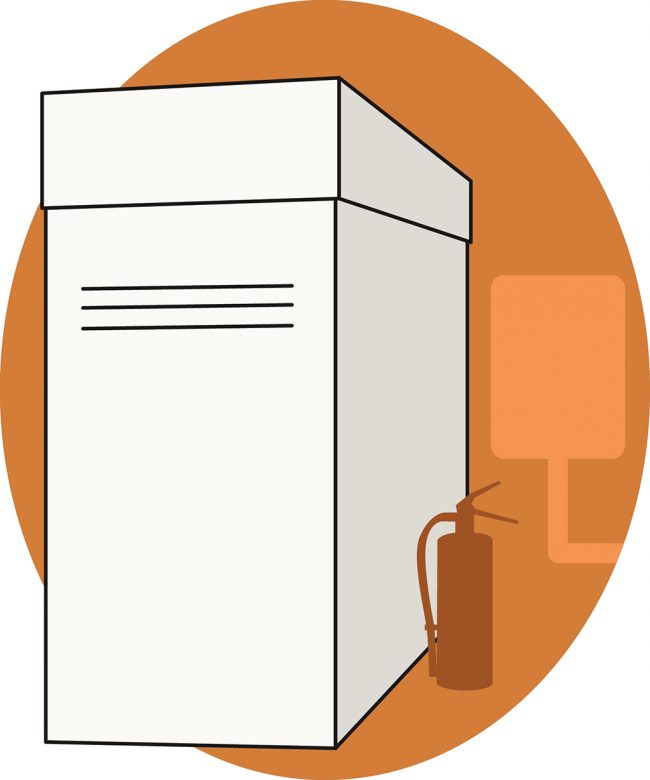
Combined Heating and Power (CHP) Units: The CHP system planned for Beyond The Grid is powered by Capstone turbine units that function like jet engines. They have only one moving part: an air bearing where pressurized air suspends bearings as they spin at 96,000 rpm. The spinning generates electricity and a lot of heat. The electricity powers the building while that heat is recovered by a heat exchanger and distributed into the building’s heat and hot water system. Unlike other kinds of CHP units, which function more like truck (or reciprocating) engines, air bearing systems have no friction. As a result, there is less wear and tear, less maintenance required, and less noise. The turbines run on a dedicated fuel, which will initially be natural gas, though Garrin hopes to explore the possibility of running them on bio- or trash- gas in the future. | Illustration by Aaron Reiss
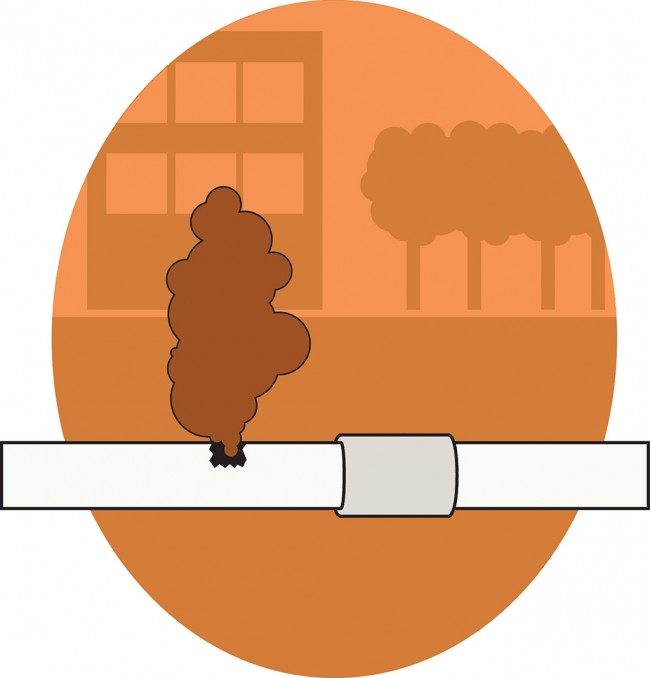
Natural Gas Grid: Beyond The Grid’s CHP units run off of the city’s natural gas grid rather than the electrical grid. The gas grid suffered far less damage than the electrical grid during Sandy and bounced back more quickly. If a building’s supply of natural gas from the city were cut off, the building would still, however, be without power. | Illustration by Aaron Reiss
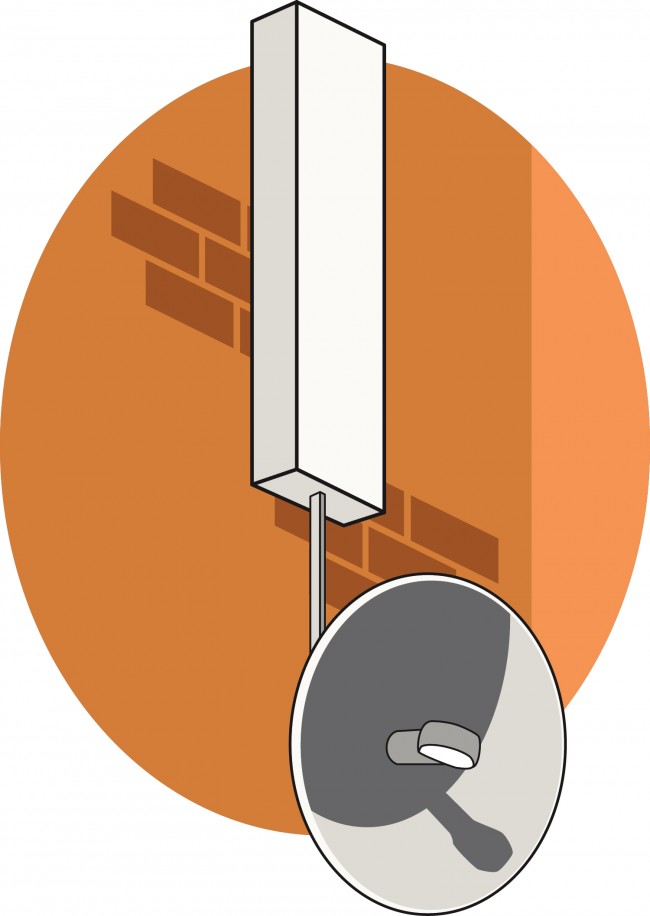
WiFi Towers: WiFi-NY has already installed two towers in the Lower East Side, which serve 50+ buildings in Lower Manhattan and North Brooklyn. While they have been providing independent Internet service for eleven years, they are still dependent on power from the city’s electrical grid to function. | Illustration by Aaron Reiss
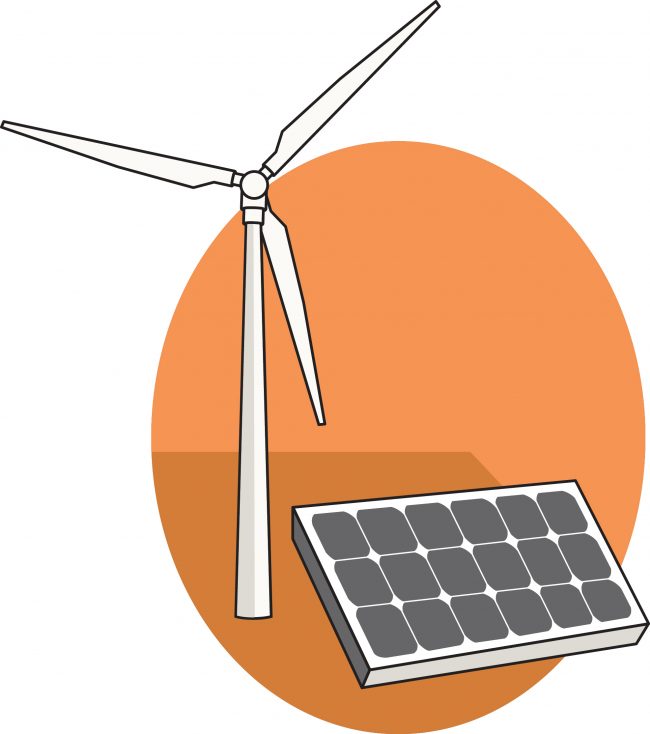
WiFi Power: In the future, Beyond The Grid hopes to run their WiFi network with solar and wind power. According to Garrin, the technology is currently available, but funding is holding that initiative back — approximately $5,000 is needed to fund each site. | Illustration by Aaron Reiss
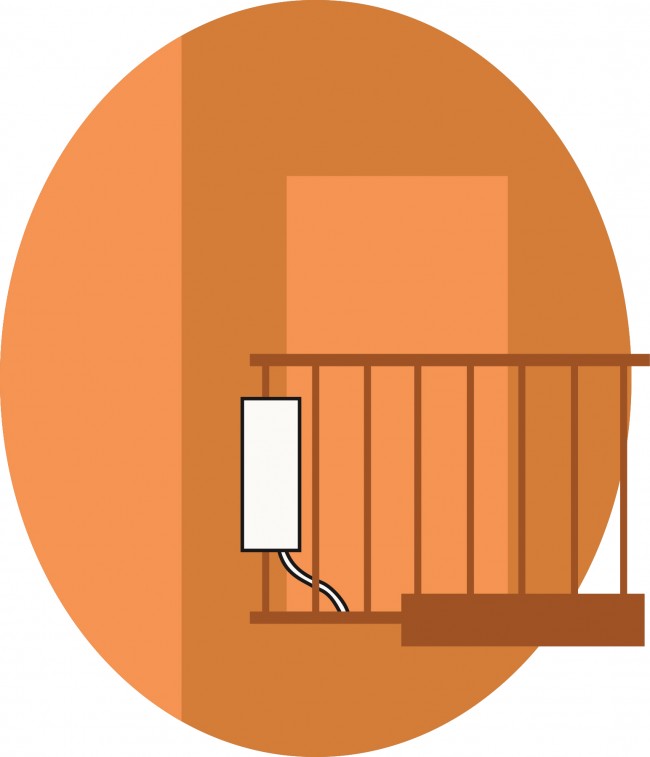
WiFi Recievers: WiFi-NY is built on a cooperative network with a social enterprise mission, where paying members ($25 a month) subsidize free WiFi access for the community (limited to 30 minute sessions with upload and download speed restrictions). A single tower serves a large number of nodes (one per building), which are connected to receivers in each apartment. There are currently over 50 WiFi-NY nodes installed in NYC. | Illustration by Aaron Reiss
An Unexpected Disaster Bears Unexpected Fruit
While talented and passionate, the team lacked engineering and technical expertise to carry out the project. “We had this plan,” Garrin explained, “but we didn’t have a way to implement it.”
Alex Nadolishny is a principal technology expert at Louis Berger, a massive engineering consulting firm that has been contracted for such projects as building and running power plants in Iraq and Afghanistan and program management for the redevelopment of the World Trade Center. In the immediate aftermath of Hurricane Sandy, the firm was called upon to assist the New York City Office of Emergency Management (OEM) with provision of emergency power-generating equipment, light towers, and fuel supply. Stationed at the OEM Logistics Center, Nadolishny recounted “getting calls like, ‘This is a nursing home; we have people on life support, and if you don’t deliver a generator within eight hours, people are going to die.’”
After donating and deploying a solar/diesel hybrid generator in the Rockaways but finding no large government agencies willing to accept it, the Louis Berger team ended up powering the command center of Occupy Sandy and Greenpeace. “[They] were extremely agile. I saw that community-level work was actually far more efficient than a lot of the efforts by governmental agencies. Obviously, they couldn’t match the scale of the government services, but the efficiency was way higher.” By the time Nadolishny was introduced to Paul Garrin, they were both convinced of the effectiveness of grassroots, community-level action. Nadolishny — employed by one of the most established engineering firms in the country — and Garrin — who co-runs a grassroots ISP out of a control room in his apartment — formed an odd, yet complementary, couple.
Nadolishny’s involvement secured the resources of Louis Berger for retrofitting low-income housing complexes in the Lower East Side at no upfront cost. With Louis Berger came Milestone Architecture to help, pro bono, with drawing up plans for the structural additions needed in the installation of new building infrastructure. With these additions to the team, and support from local groups like LES Ready, Beyond the Grid went from grand vision to a real possibility.
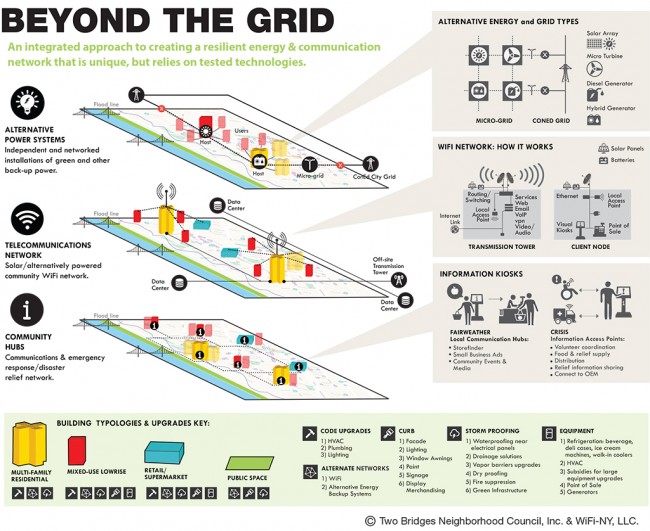
Diagram explaining the big picture vision of Beyond the Grid | Image courtesy of Two Bridges and WiFi-NY
Too Big To Fund?
The same big-picture approach that inspired the team ultimately presented an obstacle to securing funding. Grant applications to the likes of the New York City Economic Development Corporation and the Kresge Foundation were unsuccessful. Explains Culhane, “Our ideas are good, the technology is sound, but the whole package is hard to fund because it is a mix of capital and program expenses,” referring to the distinction between funding streams for construction and those for operating expenses and maintenance. She continues, “Component parts are probably easier to fund… but our integrated approach seems overwhelming to funders, or too ambitious. We’ve seen others get funding for similar components that are not part of an integrated whole.”
While the funding was not there for the grand, holistic solutions, the team made progress where it could. They secured the go-ahead from Con Edison to install their first Combined Heating and Power (CHP) system in less than a year. Luckily, in the months following Hurricane Sandy, the government was starting to offer easier and more generous funding for CHP systems. According to John B. Rhones, President and CEO of the New York State Energy Research and Development Authority (NYSERDA) — one of the major regulatory bodies providing funding and financing sources for resilient technology in New York — “After Superstorm Sandy, Governor Cuomo set an aggressive agenda to prepare the State’s infrastructure to be more resilient. … For example, NYSERDA made available an additional $100 million for combined heat and power systems that would operate during power outages.”
The Beyond The Grid team is using these revamped financing options for cogeneration to build their vision piece by piece. For the time being, the team has had to shelve parts of the plan — like solar and wind power for the WiFi system and community kiosks — but they continue to make progress by grabbing the lowest hanging fruit. Right now, that mainly means installing CHP systems in large, privately owned, affordable residential buildings and continuing to develop the WiFi network. Unfortunately, finding properties where all the necessary elements align has created a bit of a bottleneck. The Beyond The Grid team needs landlords who are willing to listen, energy demand high enough to make CHP economically viable, and building ownership and metering that happens to line up with NYSERDA funding guidelines. Chasing down leads that often don’t pan out in the short-term involves a lot of unpaid time.
But Garrin is optimistic for the future: “Though every one of these buildings is really different, we are able put a collection of these cases together, so that we are able to approach these different problems better down the road.”
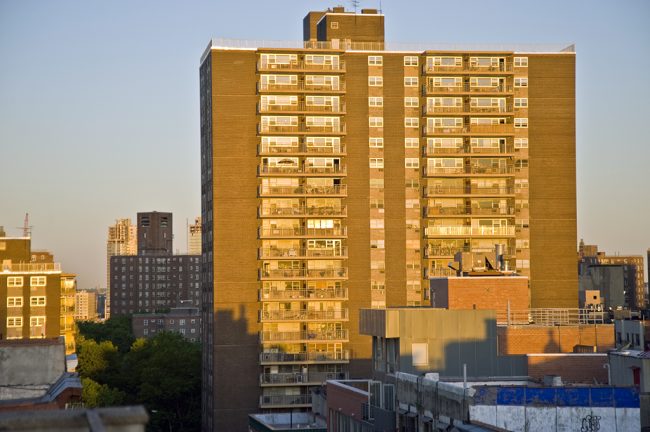
Village East Towers | Photo via Felix Castor
Looking Ahead
Back at Village East Towers on Avenue C and 10th Street, Garrin describes how they hope to break ground on their first CHP installation at this private, affordable, three-building complex in the coming year. The system at Village East will supply enough power to cover the complex’s base load. During times of high energy usage, they will pull additional power from the city grid. Currently, moving excess power generated by CHP (either selling it back to Con Edison’s grid or transferring it to a nearby property) is an incredibly cumbersome process, where it is possible or permitted at all. This hurts the economic viability of installing and running CHP systems that could supply 100% of a building’s power needs. Beyond that, connecting buildings in a microgrid would require a lot of investment in new, private infrastructure. Even then, the future of CHP in microgrids is anything but clear.
In spite of this, the Beyond The Grid team believes that microgrids in New York City are a reality on the horizon. Pending regulatory changes, increased education for property owners, and increased outreach, Garrin is banking on the ability to start creating microgrids by connecting multiple developments in the near future. “I want to see at least from 14th Street down to Downtown converted to CHP. This whole area is perfect for this kind of distributed power generation.”
He might not have to wait long; there are plenty of signs that New York City is getting excited about microgrids. In a massive post-Sandy report issued by the Mayor’s Special Initiative for Rebuilding and Resiliency, the City committed to identifying and addressing financial and regulatory barriers facing the development of distributed generation and to researching the feasibility of microgrid pilots in the five boroughs. Meanwhile, NYSERDA just announced a $40 million microgrid competition, with details to be released this winter.
In the meantime, properties like Village East, which are hoping to install on-site power generation capabilities now, are laying down what could become infrastructure in the microgrids of the future. “Once regulatory reform is finalized in New York State,” says Paul, “this will all be able to scale up.” With additional investments down the road, these microgrids could help entire sections of the city keep the power on when the city’s grid goes out.
The sheer magnitude of Sandy may really be pushing New York City into some of the more exciting territory that people like Paul Garrin have been exploring for a decade or more. We can only hope that it won’t take another disaster of this scale to motivate fresh thinking about holistic efforts to tackle the perils of our changing climate.
The views expressed here are those of the authors only and do not reflect the position of The Architectural League of New York.
Comments